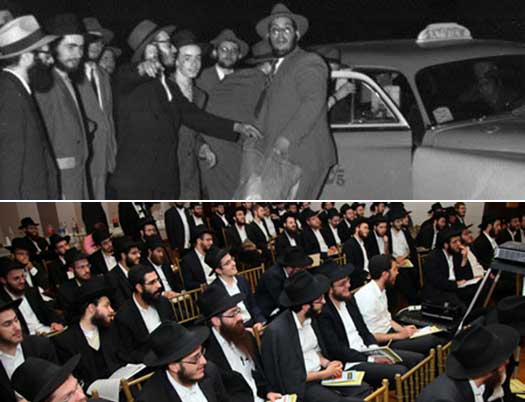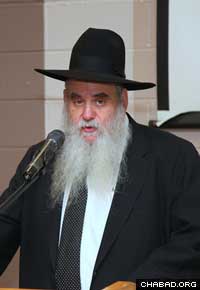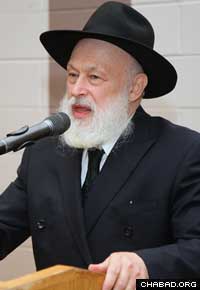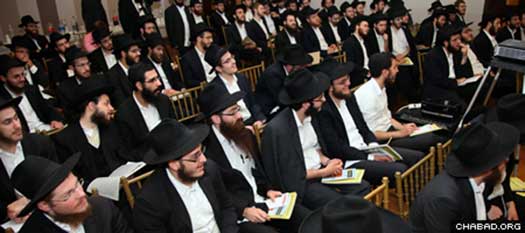
300 Rabbinical Students Heading Out for Summer Sojourns
In 1948, Leibel Posner was about to spend five weeks on the road, traveling throughout the farmlands, towns and cities of New Jersey, Delaware and Pennsylvania. The 19-year-old yeshivah student was instructed to travel on what was then called the “milk train,” which stopped at every local station, where he would disembark to meet Jews in each community, offering Jewish books and subscriptions to Torah literature.
At the same time, his elder brother Zalman, together with fellow student Mendel Baumgarten, had been dispatched to Europe to serve the needs of Holocaust survivors and refugees from Stalinist oppression living in displaced-persons camps throughout the continent.
Before he left, Posner was granted a private audience with the sixth Lubavitcher Rebbe, Rabbi Yosef Yitzchak Schneersohn, of righteous memory. Ailing and frail, the Rebbe leaned forward in his seat and said, “When you meet another person, make sure that you look for his strong points. At the same time, do not overlook his weak points. The Torah has some large letters and some small letters. Chassidim used to say: we need to see a person’s fine qualities in big letters, and take note of their shortcomings with small letters,” for the sake of helping to correct them. The Rebbe blessed him with success, and Posner set off.
The American-raised Talmud scholar was one of the first to participate in the now legendary summer program known as “Merkos Shlichus.” Shlichus means “mission,” or “ambassadorship,” which was undertaken on behalf of the Rebbe’s educational arm, Merkos L’Inyonei Chinuch, known colloquially as “Merkos.”

It was a summer rite of passage for Chabad-Lubavitch yeshivah students, and a lifeline for small communities and isolated Jews. Each summer, pairs of students were dispatched all over the globe by the Rebbe’s son-in-law, Rabbi Menachem M. Schneerson, of righteous memory, with instructions to share Jewish awareness, observance and knowledge. The latter served as chairman of Merkos L’Inyonei Chinuch and subsequently succeeded his father–in-law as the leader of the Chabad-Lubavitch movement.
In the early years, the Rebbe would personally map out the students’ routes, pointing out far-flung communities with particular needs or requests, and scattered individuals in need of counsel and encouragement. Even decades later, the Rebbe would sometimes deliver a special talk for the students, encouraging them, advising them and blessing them with success as they embarked on their summer mission.
Setting Off to Far-Flung Destinations
Nowadays, even as air travel, GPS navigation and videoconferencing make for a more modern-day experience, the underlying themes of Torah, ahavas Yisrael (love of the Jewish people) and selfless dedication remain the same.
This year, some 66 years later, 300 yeshivah students are poised to travel to far-flung destinations like Greece, Nepal and Peru with tefillin, mezuzahs, Jewish supplies and timeless Torah scholarship.
Rabbi Moshe Kotlarsky, who directs the program as vice chairman of Merkos, opened the annual training session last week in the Crown Heights neighborhood of Brooklyn, N.Y. He shared details from some of the private talks the Rebbe would have with the students, and introduced a specially prepared clip from a 1970 address by the Rebbe to the Merkos Shlichus emissaries.
In it the Rebbe discussed the importance of reaching out to individual Jews, wherever they live, and the responsibility of the emissary to act like a lamp, shining with Torah knowledge and inspiration.
Rabbi Yehuda Krinsky, chairman of Merkos, shared personal memories, including his time spent as a Roving Rabbi from 1951 to 1957. He told how young men would sometimes leave with nothing other than a list of cities—no phone numbers, no contacts, just samples of Talks and Tales, Lubavitch’s Yiddish/English periodical. They would sometimes sleep on synagogue pews or floors as they worked their way through rural America.
Clearly, the Merkos Shlichus logistics have evolved in many ways since then. Cell phones and email have alleviated much of the isolation, and allow for better planning and coordination. Many students will be based out of Chabad centers—some of which were established on the foundations laid by previous Roving Rabbis.

Basic Themes Remain the Same
Despite the changes over the years, the students were exhorted to maintain the same rigor as their forebears.
Chabad emissary to Puerto Rico Rabbi Mendel Zarchi, who oversees the Roving Rabbis dispatched regularly to various Caribbean islands, cited the Rebbe’s call to students to take their personal Torah texts with them. He also encouraged the students to write detailed reports on their meetings, reminding them how the Rebbe used to pore over the reports, often following up with letters or telegrams to people the students met.
Zarchi was followed by Rabbi Efraim Mintz, who served as a Roving Rabbi in California in 1990. Mintz, who directs the Rohr Jewish Learning Institute, shared tips and advice on honing a Torah “elevator pitch,” as well as ideas about presenting more advanced Torah thoughts on a variety of subjects to share with others during the course of their travels.
Rabbi Dov Greenberg, director of the Rohr Chabad House serving Stanford University in Palo Alto, Calif., further elaborated on how to bring Torah references and ideas to light. And he urged the students to go beyond their perceived limitations: “Right when you think you are ready to call it a day, make sure to knock on one last door, reaching out to one last person.”
“The message that I took from the presentation is that it is not about you,” said Eli Nachum Block, who’s headed to San Antonio, Texas. “It is hard work, physically and emotionally. Making phone calls and meeting people day after day can be draining. The point is, though, that we are part of something bigger than ourselves, and that we are there to serve the community and to serve every single individual.”
Kotlarsky noted in his introduction some very important “fringe benefits” for the rabbinical students.
“The students are going not only to teach, but to listen as well,” he said. “Many of these young men will become full-time Chabad emissaries, and this experience gives them invaluable exposure to the rich diversity of our nation and the world.”



































r` m kotlarsk
How are the shadchanim gonna see our faces in the picture, Its not clear enough.
Vania
This statement is false acndoricg to most of the Chabad world. When I say most I mean by the over 4,000 Chabad centers around the world you will not hear that statement from them.